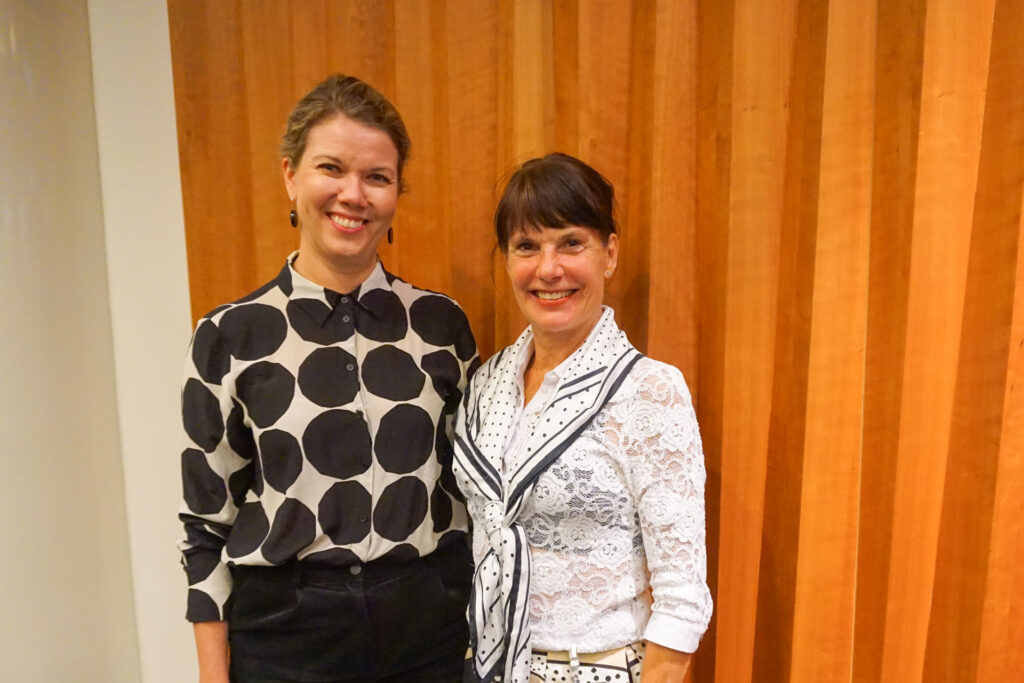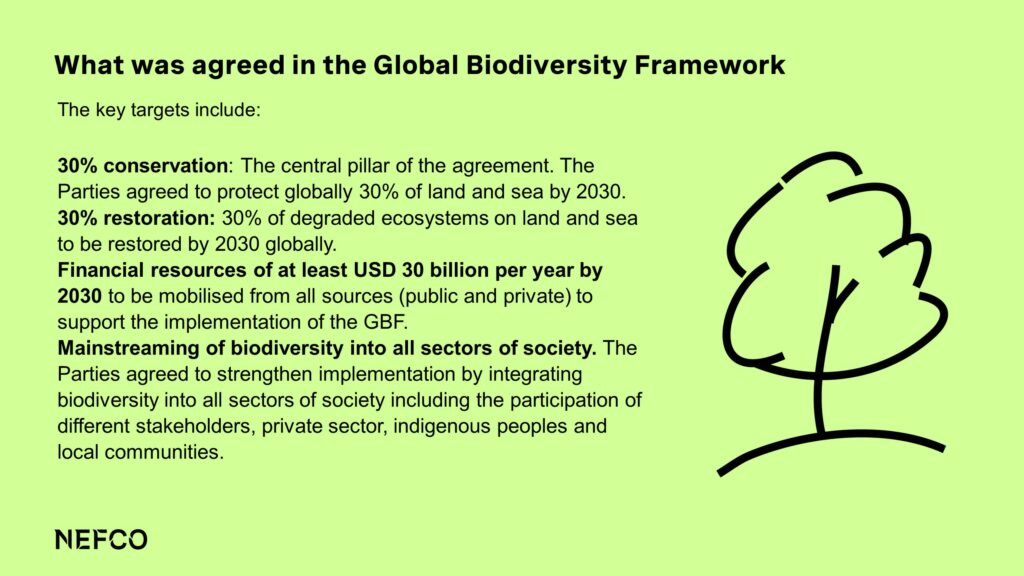07.09.2023 | Insight
30-30-30. Those are the key figures to remember when it comes to the Global Biodiversity Framework according to Marina von Weissenberg, Senior Ministerial Adviser at the Finnish Ministry of the Environment and Finland’s Chief Negotiator for Biodiversity. Von Weissenberg gave a presentation to Nefco on the results of COP15 and the objectives and implementation of the Global Biodiversity Framework.

The historical Kunming-Montreal Global Biodiversity Framework was adopted by Parties to the Convention on Biological Diversity (CBD) on 19 December 2022. The CBD has 196 Parties and the EU and is truly global. Together with the Paris Agreement on climate, the Global Biodiversity Framework (GBF or later Framework) paves the way towards a climate-neutral, nature-positive and resilient world by 2050.
During her presentation at Nefco on 28 August 2023, Marina von Weissenberg, Senior Ministerial Adviser at the Finnish Ministry of the Environment and Finland’s Chief Negotiator for Biodiversity summed up the core outcome and spirit of the Global Biodiversity Framework in two words: nature positive. It means enhancing the resilience of our planet and societies to halt and reverse nature loss.
The GBF consists of four overarching global goals to protect nature, including halting human-induced extinction of threatened species and reducing the rate of extinction of all species tenfold by 2050. It also includes 23 targets to achieve by 2030.
“The annual value of ecosystem services is USD 150 billion, but they are losing value as we speak.”
Marina von Weissenberg, Senior Ministerial Adviser, Ministry of the Environment, Finland
Nature-positive solutions are key
“The GBF is not only about restoring and protecting the 30% but also about enhancing biodiversity on the remaining 70% of our land and water areas by, for example, reducing plastic pollution and harmful substances and changing the way use natural resources,” von Weissenberg said.
“The annual value of ecosystem services is USD 150 billion, but they are losing value as we speak. We have been using biodiversity as a free asset. If we lose biodiversity, we lose natural resources and thereby we lose the business case.”
Von Weissenberg stressed the importance of promoting and using nature-based solutions to conserve, restore, sustainably use and manage our ecosystems and species. “The overconsumption of the world’s resources cannot continue. The use of natural resources for free is coming to an end.”

Implications for businesses and investments
The Framework includes strengthened mechanisms for reviewing implementation. As von Weissenberg highlighted, “All parties need to develop national biodiversity strategies and action plans prior to the next COP meeting in 2024. The impact of the national actions will be evaluated to see if they are sufficient to reach the global goals and targets.” The Framework also has a requirement for national finance plans and evaluation of harmful subsidies by 2025.
The Global Biodiversity Framework is not only about restoring and protecting the 30% but also about enhancing biodiversity on the remaining 70% of our land and water areas.
According to von Weissenberg, in Europe, the implementation of the Framework is managed through many new EU Directives, including the EU Taxonomy, and its Do No Significant Harm requirements, and through EU and national legislation on nature conservation, which will have implications for businesses and new investments.
Target 15: catalyst for action for financiers and companies?
Financiers play an essential role in incentivising, mitigating and preventing the major drivers of biodiversity loss. They can accelerate or slow down drivers based on their financing decisions and portfolios.
One of the Framework targets highlighted by von Weissenberg during her presentation was Target 15, which focuses on business and financial institutions. It requires all large businesses and financial institutions to assess and disclose their risks, impacts and dependencies on nature through their operations, supply and value chains, and portfolios.
Target 15 can incentivise banks to establish strong biodiversity criteria for their portfolios. This further enables them to effectively manage nature-related risks and reduce financial losses due to negative nature impacts on their portfolio.
Target 15 requires all large businesses and financial institutions to assess and disclose their risks, impacts and dependencies on nature.
Direct financing for biodiversity is also needed. Recently, a new Global Biodiversity Framework Fund was established to ramp up investment in nature restoration and renewal. Focused on the sustainability of biodiversity and ecosystems, the new fund will mobilise and disburse additional resources from public, private and philanthropic sources to developing countries. Von Weissenberg concluded that the creation of the new fund, which is managed by the Global Environmental Facility (GEF), marks an important step towards protecting nature and the planet.
How Nefco is targeting biodiversity and habitat loss
As a Nordic-owned international financial institution, it is important for Nefco to consider long-term risks related to biodiversity and natural capital. The focus is on ensuring that possible environmental risks, such as biodiversity impacts, are sufficiently considered and appropriately mitigated in project design and during operations.
- Restricting investments to sectors with biodiversity risk: One of the requirements for financial institutions, according to the Global Biodiversity Framework, is to reduce negative impacts on biodiversity, and Nefco has therefore established ‘no go’ areas. This action was taken by Nefco in 2022, when we renewed our Environmental and Sustainability Policy. In the new Policy, we have ruled out financing to some sectors that have negative impacts on biodiversity, such as forestry and animal husbandry. The new Policy aims to protect primary and old-growth forests and high conservation value areas, and Nefco therefore refuses to finance any commercial activities in these areas.
- Impact and dependency screening of Nefco’s investment portfolio: Nefco will evaluate high-risk sectors and risk areas in its portfolio and consider the need for strengthened environmental assessment practice during autumn 2023.
- Identifying possibilities to finance nature-positive investments: Nefco has started to identify areas where nature-positive investments or actions can be carried out.
- Biodiversity Pilot Programme: Nefco’s Biodiversity Pilot Programme, initiated in 2022, will contribute to knowledge transfer and learning and deliver positive biodiversity impacts and conservation outcomes. The aim is to create a demonstration effect and inspire more companies and project owners to think in terms of nature-positive measures.
Contact us
